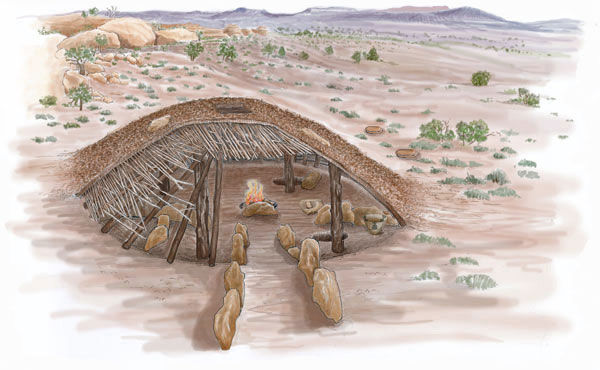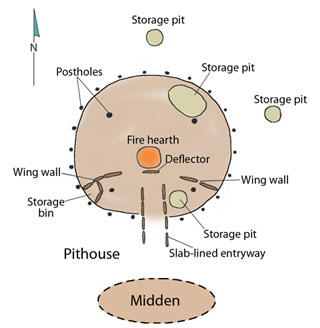Peoples of the Mesa Verde Region
Basketmaker II: 500 B.C. to A.D. 500Housing

"Cutaway" view of a Basketmaker II pithouse, showing construction details and interior features (also note the two slab-covered storage pits to the right of the pithouse). This particular style of house is found in the western part of the Mesa Verde region. As people made the transition from a nomadic hunting and gathering lifestyle to a more settled farming lifestyle, they began building structures that were more permanent than those built during earlier time periods. Some houses were built in rock alcoves; others were built in the open. Basketmaker II house styles varied in the Mesa Verde region and adjacent areas, depending on where and when they were built. Archaeologists think these architectural differences may reflect the different origins of the Eastern and Western Basketmaker peoples during the preceding Archaic period. In the eastern part of the region, archaeologists have documented Basketmaker II houses constructed using the "cribbing" technique first seen in this area during the preceding Archaic period. The walls of these circular, domed structures consisted of horizontally stacked logs. The floors were usually constructed flush with the ground surface rather than being dug belowground. 
Map of Basketmaker II farmstead (schematic). In the western part of the region, the typical home during the Basketmaker II period consisted of a shallow, basin-shaped pithouse that was dug into the earth. The floor and the lower part of the house walls were belowground and consisted of dirt. The roof was supported by four sturdy posts set in the floor. Smaller posts set at intervals around the edges of the structure were leaned against the roof beams and then covered with branches and other plant materials to form the walls. Finally, the entire outside of the structure was covered with a layer of earth. The entryway was usually located in the south wall and often consisted of a slab-lined ramp that sloped from the ground surface down into the pithouse. Inside the pithouse was a central hearth that provided heat and light; smoke from the hearth escaped through a hole in the roof. In addition, archaeologists have found early examples of two architectural features that became standard fixtures in later homes: deflectors and wing walls. A deflector is a barrier erected just south of the hearth for the purpose of shielding the fire from the stream of air that blew in through the entryway. During the Basketmaker II period, deflectors often consisted of upright sandstone slabs set in the floor. Wing walls are low walls that extend from the sides of the pithouse toward the center of the floor, near the deflector. They helped control air circulation in the pithouse and also subdivided the living area. During Basketmaker II times, these, too, were often made of upright stone slabs. By the end of the Basketmaker II period, a new style of pithouse began to appear—one that consisted of two distinct chambers. This new style became the predominant house form throughout the Mesa Verde region during the subsequent Basketmaker III period and is described in detail in that section. With the increased focus on agriculture, people during the Basketmaker II period were more likely than those of earlier periods to have surplus food, which—if properly stored—could help them survive the winter. Storage pits are found both inside and outside Basketmaker houses, sometimes covered with large, flat rocks to protect their contents and provide a level walking surface. Storage bins made of upright stone slabs are also found inside homes. With people living in the same place for prolonged periods, large quantities of refuse accumulated, usually in a designated area south of their houses. An area of concentrated refuse is called a "midden," and such deposits contain ash, broken artifacts, and discarded food scraps that help archaeologists reconstruct ancient lifeways. |
|
Acknowledgments | Illustration credits | To borrow, cite, or request permission | Please take our survey! Title page for Peoples of the Mesa Verde Region |
|
 DONATE TODAY
DONATE TODAY
